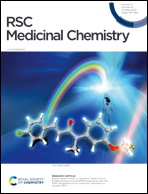Synthesis and biological evaluation of paeoveitol D derivatives as new melatonin receptor agonists with antidepressant activities†
Abstract
Our previous study demonstrated that paeoveitol D, a benzofuran compound isolated from Paeonia veitchii, displayed activity on MT1 and MT2 receptors with agonistic ratios of 57.5% and 51.6% at a concentration of 1 mM. To explore the structure–activity relationships, 34 paeoveitol D derivatives were synthesized and evaluated for their MT1 and MT2 agonistic activities using the Fluo-8 calcium assay. Among them, 16 and 18 derivatives increased agonistic activities on the MT1 and MT2 receptors, respectively. Compound 18 indicated EC50 values of 21.0 and 298.9 μM on MT1 and MT2 receptors in agonistic dose response curves with Tango assays and shortened immobility time in the forced swim test. The preliminary mechanism-of-action investigation manifested that the antidepressant activity of compound 18 may be mediated by promoting serotonin (5-HT) and dopamine (DA) levels in the mice brain. Compound 18 also showed favorable pharmacokinetic profiles and low toxicity in vivo. These results suggest that compound 18 could be a potential antidepressant agent.



 Please wait while we load your content...
Please wait while we load your content...